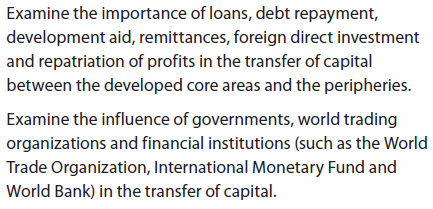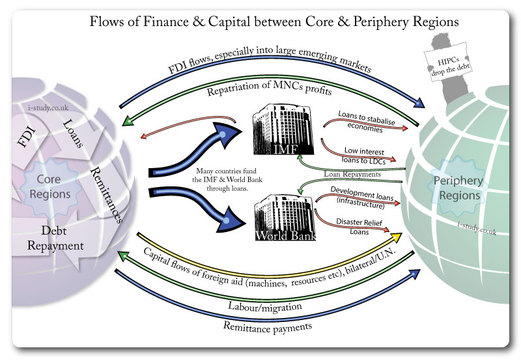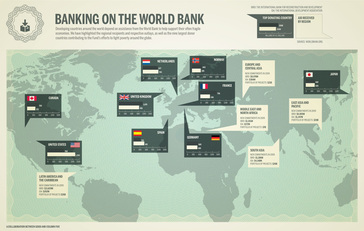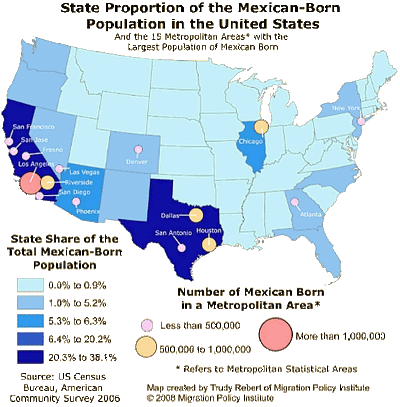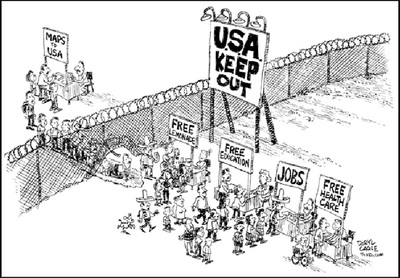Please help keep the Geographer Online a FREE resource
Economic interactions and flows
Index
Financial Flows
Key Terms
|
|

Discuss the various financial flows in the following image. Print image and annotate with examples.
|
| ||||||||||||
Collaborative Research: Create a Google document where each person researches a case study on the importance of:
For each case study you should explain the Financial Flow and how it works, give a real life example with factual content and assess the importance of it.
- Loans
- Debt repayment
- Development aid
- Remittances
- Foreign direct investment
- Repatriation of profits
For each case study you should explain the Financial Flow and how it works, give a real life example with factual content and assess the importance of it.

Example Available
Governments
The aim of all national governments is either to try and balance their budget or to get a budget surplus (unfortunately most countries run a deficit). As well as balancing spending and taxation governments also need to look at the their levels of imports and exports. Governments can increase or decrease imports and exports in some of the following ways
The aim of all national governments is either to try and balance their budget or to get a budget surplus (unfortunately most countries run a deficit). As well as balancing spending and taxation governments also need to look at the their levels of imports and exports. Governments can increase or decrease imports and exports in some of the following ways
|
National governments can try and increase flows of global trade in a number of ways including:
|
They can also try and reduce flows of global trade in some of the following ways:
|
|
|
|
|
Make some notes on how governments influence world trade:
|
|
World Trade organisations
The WTO started its life as GATT (General Agreement on Tariffs and Trade). GATT was established in 1948. GATT involved member countries meeting (rounds) to discuss and agree tariffs over trade. The final round in Uruguay (1986-94) agreed to establish its successor the WTO. The WTO officially began life on the 1st January 1995. The WTO Is based in Geneva and now has 153 members who between them represent 97% of total world trade. Although GATT only looked at the trade of goods, the WTO also looks at the trade of services and intellectual property rights. The aim of the WTO is to:
The WTO started its life as GATT (General Agreement on Tariffs and Trade). GATT was established in 1948. GATT involved member countries meeting (rounds) to discuss and agree tariffs over trade. The final round in Uruguay (1986-94) agreed to establish its successor the WTO. The WTO officially began life on the 1st January 1995. The WTO Is based in Geneva and now has 153 members who between them represent 97% of total world trade. Although GATT only looked at the trade of goods, the WTO also looks at the trade of services and intellectual property rights. The aim of the WTO is to:
- Liberalise (free) world trade (reduce protectionism)
- Create a forum for governments to negotiate global trade agreements
- Be a place to settle trade disputes
- Be a place to set and clarify trade rules.
- The WTO's most recent negotiations were in Doha, Qatar. The aim of the negotiations was to involve LEDCs more in global trade. One of the major sticking points in the talk was Europe's and the US's refusal to cut farm subsidies.
Financial Istitutions
|
International Monetary Fund (IMF)
The IMF like the World Bank was created at Bretton Woods in 1944. It started with only 46 members but has now grown to include 186. Member countries all contribute to a pool of money which member countries can then borrow on a temporary basis to overcome budget deficits/imbalances. The IMF was extremely important after WWII to help stabilise the global economy. The IMF has taken a leading role during the current global economic crisis. It has sold gold reserves to increase it pool of money and the G20 leaders have pledged a further $500 billion to allocate to other members suffering from budgetary problems. Even though the IMF is currently taking a leading role in the economic crisis, it has been heavily criticised. Criticisms include:
http://www.imf.org/ |
World Bank
The World Bank was established in Bretton Woods in 1944 and has its headquarters in Washington DC. The World Bank is not a traditional high street bank, but a global one owned by its member countries (187 countries). It has two main institutions, the International Bank for Reconstruction and Development and the International Development Association. The bank has over 10,000 employees and over 100 offices around the world. In its early days the bank did not lend much money, but then in the late 1960's and 1970's it started lending more money to developing countries in order to fund schools, hospitals, infrastructure projects, etc. In the 1980's the World Bank along with the IMF imposed SAP (structural Adjustment programmes) on many of its borrowers. From the 1990's onwards the World Bank is now more interested in helping countries achieve the UN's Millennium Development Goals. This includes reducing poverty, improving health and education and ensuring sustainable growth. The World Bank has had a number of criticisms including:
http://www.worldbank.org/ |

IB Style Question:
Explain how various organisations influence the financial flows [10]
|
|
|
Labour Flows
Key Terms
|
|
Case Study
Create a set on notes on the flow of Mexicans to the USA
'Global Interactions' book page 73-80
(There is a useful link here to the case studies we looked at in migration - Core 1)
You will need to explain:
How many people have migrated?
Reasons for their migration (stick to the work related issues)
Causes and Effects of this migration (It is VERY important to look at both country of origin and destination here)
How has the USA tried to limit migration from Mexico? (what methods have they used)
How successful have the US attempts been to limit this migration?
Background
More than 11% of Mexico’s native population lives abroad, making it the country with the most emigrants in the world. 97% of all Mexican emigrants reside in the United States, which are more than 12 million (legal and illegal) migrants. Estimates on the amount of Mexican emigrants of indigenous origin in the U.S. range between 50% and 90% of the entire emigrant population.
Possible Resources:
Create a set on notes on the flow of Mexicans to the USA
'Global Interactions' book page 73-80
(There is a useful link here to the case studies we looked at in migration - Core 1)
You will need to explain:
How many people have migrated?
Reasons for their migration (stick to the work related issues)
Causes and Effects of this migration (It is VERY important to look at both country of origin and destination here)
How has the USA tried to limit migration from Mexico? (what methods have they used)
How successful have the US attempts been to limit this migration?
Background
More than 11% of Mexico’s native population lives abroad, making it the country with the most emigrants in the world. 97% of all Mexican emigrants reside in the United States, which are more than 12 million (legal and illegal) migrants. Estimates on the amount of Mexican emigrants of indigenous origin in the U.S. range between 50% and 90% of the entire emigrant population.
Possible Resources:
| poverty-in-mexico-fact-sheet.pdf | |
| File Size: | 417 kb |
| File Type: | |
|
|
|
Information Flows
Key Terms
|
|
Watch the two YouTubes below and discuss what Outsourcing is.
|
|
|
Outsourcing: The process of taking internal company functions and paying an outside firm to handle them. The process of outsourcing part of your business operations to another company is known as subcontracting.
|
The reasons companies outsource can vary, but may include:
|
In order for cities, regions or countries to become attractive locations for TNCs to outsource, they will have to fulfill numerous requirements including:
|
Outsourcing in the world
| at_kearney_offshoring_report.pdf | |
| File Size: | 2368 kb |
| File Type: | |

Create a one page document explaining which regions are the most attractive in the world for outsourcing.
- Why is it? (what do they offer)
- Advantages and disadvantages (home sentiment)
- Use facts and figures

Case Study: Outsourcing and Apple
Create a mind map with examples of how Apple outsource around the world. Use Coggle to make the mind map.
(Where - What - Why?)
Sources:
Create a mind map with examples of how Apple outsource around the world. Use Coggle to make the mind map.
(Where - What - Why?)
Sources:

IB Style Question:
Explain why companies outsource certain functions [10]
Explain why companies outsource certain functions [10]
|
|
|

